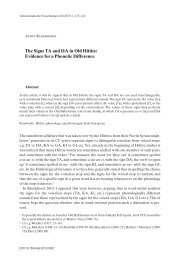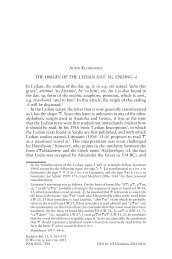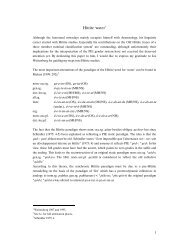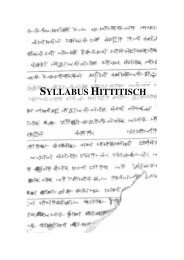Indo-European Nominal Ablaut Patterns - Alwin Kloekhorst ...
Indo-European Nominal Ablaut Patterns - Alwin Kloekhorst ...
Indo-European Nominal Ablaut Patterns - Alwin Kloekhorst ...
Create successful ePaper yourself
Turn your PDF publications into a flip-book with our unique Google optimized e-Paper software.
The hypothesis that the proterodynamic and the hysterodynamic paradigms are both representatives of<br />
a single underlying mobile paradigm, is supported by the fact that the nom.sg. form, *CéC-C, and the<br />
loc.sg. form, *CC-éC, are identical in shape in both paradigms.<br />
The exact origins of these ablaut patterns must lie in pre-Proto-<strong>Indo</strong>-<strong>European</strong> times, and it would go<br />
beyond the scope of this paper to speculate on these. Yet, a few predictions can be made: the<br />
difference between static vs. mobile inflection was probably dependent on the phonetic shape of the<br />
root, whereas the difference between the proterodynamic and the hysterodynamic inflection must have<br />
been due to the morphologic / syntactic differences between neuter and non-neuter words.<br />
References<br />
Beekes, R.S.P., 1985, The Origins of the <strong>Indo</strong>-<strong>European</strong> <strong>Nominal</strong> Inflection, Innsbruck.<br />
Beekes, R.S.P., 1995, Comparative <strong>Indo</strong>-<strong>European</strong> Linguistics. An Introduction, Amsterdam -<br />
Philadelphia.<br />
Clackson, J., 2007, <strong>Indo</strong>-<strong>European</strong> Linguistics. An Introduction, Cambridge.<br />
Fortson IV, B.W., 2004, <strong>Indo</strong>-<strong>European</strong> Language and Culture. An Introduction, Oxford.<br />
Friedrich, J., 1952, Hethitisches Wörterbuch, Kurzgefaßte kritische Sammlung der Deutungen<br />
hethitischer Wörter, Heidelberg.<br />
Hajnal, I., 1995, Der lykische Vokalismus. Methode und Erkenntnisse der vergleichenden anatolischen<br />
Sprachwissenschaft, angewandt auf das Vokalsystem einer Kleincorpussprache, Graz.<br />
<strong>Kloekhorst</strong>, A., 2008, Etymological Dictionary of the Hittite Inherited Lexicon, Leiden - Boston.<br />
<strong>Kloekhorst</strong>, A., fthc.a, Hittite ‘water’, to appear in The Heart of the Matter (Fs. J.J.S. Weitenberg), see<br />
also www.kloekhorst.nl.<br />
<strong>Kloekhorst</strong>, A., fthc.b, The accentuation of the PIE word for ‘daughter’, to appear in the Proceedings<br />
of the Third International Workshop on Balto-Slavic Accentology.<br />
Kortlandt, F., 1975, Slavic Accentuation. A Study in Relative Chronology, Lisse.<br />
Kortlandt, F., 1986, Review of: P.P. Anreiter, Bemerkungen zu den Reflexen indogermanischer<br />
Dentale im Tocharischen, Bibliotheca Orientalis 43, 557-560.<br />
Kortlandt, F., 2001, The <strong>Indo</strong>-Uralic Verb, www.kortlandt.nl.<br />
Kortlandt, F., 2009, Balto-Slavic Accentuation Revisited, www.kortlandt.nl.<br />
Kroonen, G., 2007, On the ablaut of Gr. νέφος, Skt. ámbhas- and Lat. nimbus ‘rain cloud’, paper<br />
presented at the 4th <strong>Indo</strong>-<strong>European</strong> Colloquium Leiden-Münster, Leiden, May 7-8 2007.<br />
Kuiper, F.B.J., 1942, Notes on Vedic Noun-Inflexion (= Mededeelingen der Nederlandsche Akademie<br />
van Wetenschappen, Afdeeling Letterkunde, Nieuwe Reeks 5, 4), Amsterdam.<br />
Meier-Brügger, M., 2002, <strong>Indo</strong>germanische Sprachwissenschaft, Berlin - New York.<br />
Melchert, H.C., 1994, Anatolian Historical Phonology, Amsterdam - Atlanta.<br />
Neu, E., 1980, Studien zum endungslosen „Lokativ“ des Hethitischen, Innsbruck.<br />
Pedersen, H., 1926, La cinquième déclinaison latine (= Historisk-Filologiske Meddelelser udgivne af<br />
det Kgl. Danske Videnskabernes Selskab XI, 5), København.<br />
Pinault, G.-J., 2007, A Star is Born: A “New” PIE *-ter-Suffix, Verba Docenti. Studies in Historical<br />
and <strong>Indo</strong>-<strong>European</strong> Linguistics Presented to Jay H. Jasanoff by Students, Colleagues, and<br />
Friends (ed. A.J. Nussbaum), 271-279.<br />
Puhvel, J., 1997, Hittite Etymological Dictionary. Vol. 4 Words beginning with K, Berlin - New York.<br />
Rieken, E., 1999, Untersuchungen zur nominalen Stammbildung des Hethitischen, Wiesbaden.<br />
Rieken, E., 2002, Review of: S. Kimball, Hittite Historical Phonology, Kratylos 47, 96-103.<br />
Rix, H., 1976, Historische Grammatik des Griechischen, Darmstadt.<br />
Schindler, J., 1967, Tocharische Miszellen, <strong>Indo</strong>germanische Forschungen 72, 239-245.<br />
Schindler, J., 1975a, L’apophonie des thèmes indo-européens en -r/n, Bulletin de la Société de<br />
Linguistique de Paris 70, 1-10.<br />
Schindler, J., 1975b, Zum <strong>Ablaut</strong> der neutralen s-Stämme des <strong>Indo</strong>germanischen, Flexion und<br />
Wortbildung (ed. H. Rix), 259-267.<br />
Szemerényi, O., 1956, Latin rēs and the <strong>Indo</strong>-<strong>European</strong> long-diphthong stem nouns, Zeitschrift für<br />
Vergleichende Sprachforschung 73, 167-202.<br />
Vaan, M.A.C. de, 2003, The Avestan Vowels, Amsterdam - New York.<br />
Wackernagel, J., 1896, Altindische Grammatik 1, Lautlehre, Göttingen.<br />
12






